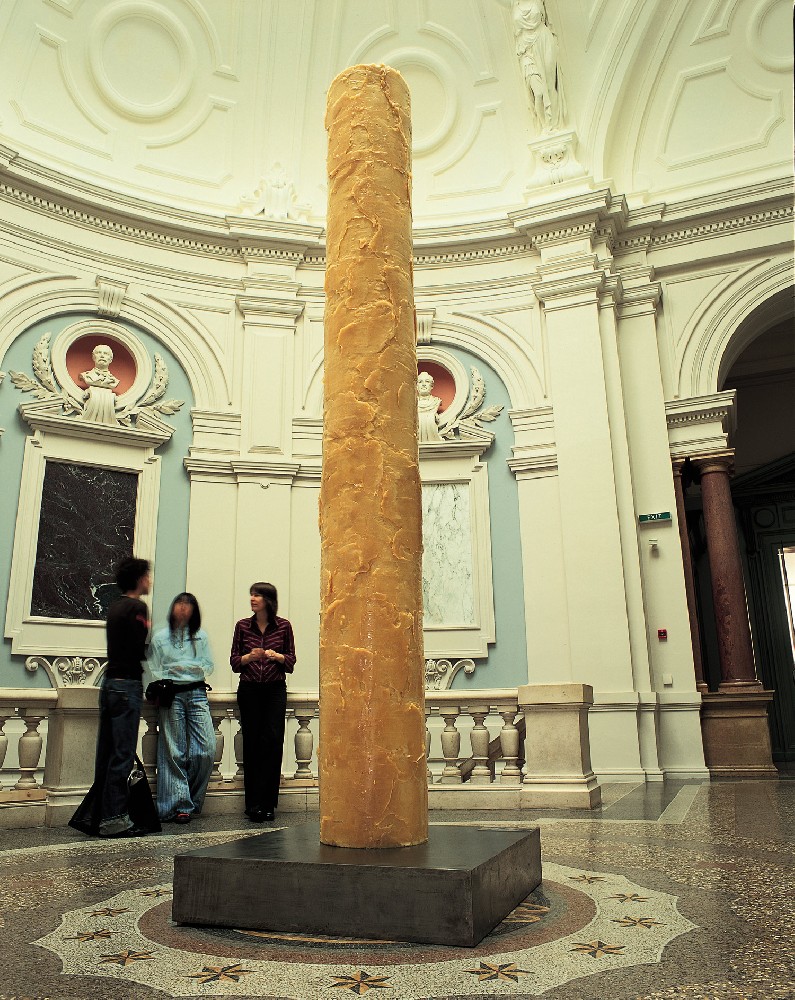Civilization Pillar
Civilization Pillar
文明柱
2001
High 400cm Diameter 60cm
Human Fat、 Wax、 Metal Underprop
2001《Yokohama 2001: International Triennial of Contemporary Art》, Yokohama, Japan
2005《Mah-jong Contemporary Chinese Art from the Sigg Collection》, Kunstmuseum, Bern, Switzerland
高400cm 直径60cm
人的脂肪、腊、 金属支撑
2001 《失重》,Galerie Volker Diehl,柏林,德国
2001《横滨国际艺术三年展》,横滨,日本
2005《麻将—中国当代艺术希克收藏展》,伯尔尼美术馆,伯尔尼,瑞士
Civilization Pillar
Akira Tatehata
Looking back on human
history, we can easily find out that columns or pillars can be found in
the ruins of every civilization as an architectural element, and
therefore could be regarded as the symbol of civilizations. Not only
have those imposing temples in which columns stood endured a lengthy
history, the column also functions as a modernist edifice and the
manifestation of internationalism or a certain type of ideology of the
20th century.Behind all types of symbolism, lie the metaphors that are
rooted deeply in people's consciousness.Sun Yuan & Peng Yu have
exhibited their work Civilization Pillar in the Yokohama Triennial. It
is a piece of work that signified a turning point in their 10 years of
art practice. The issues of death and life, flesh and concept have been
fused metaphysically in this work. By using the human corpse as a medium
for art, their
radical practices have constantly challenged the social taboos
in society. Placed on a pedestal, the 4 meter-high bright-colored column
is made of greasy and sticky human fat. It looks like something from a
magnificent temple from a distance, but it is actually a signifier, a
monument, that symbolizes our own time.The artists have written that
"man could consume all the extra energies within the human 'pillar,' and
there is no need to think about the meanings that lie behind doing
that. Because the 'Magnificent Pillar' itself is just the accumulation
of human fat, therefore the existence of the pillar is totally
meaningless." It's not simply nihilism or satiricism, but rather a
reflection upon human civilization, society and history, from their
specific perspectives.The pillar is a semi-translucent column with an
amber appearance.Because it is made of human fat, it has the appearance
of a fleshy luster, and could easily evoke for the audience the
resonance of erotic feeling. The sharp concept and the visual impact
aroused by the work are also typical characteristics of the duo. It's
not about formalistic frightfulness; instead this is a poignant
experimental work that brings focus on some fundamental issues.
文明柱
建哲
回顾人类历史的发展过程,不难发现,柱子始终作为最能象征每个时代的 文明之物而存在。不仅仅是威武壮观的神殿或者宫殿所拥有的柱子,还是那些纯粹是为了满足构造需求而建设的近代主义柱子,在现在都成为了: 排除地方风味的、国际风格的、二十世纪特有的意识形态产物,对于这一点是众所周知。在各种不同象征意义的背后,当然潜在着基于深层的心理作用的隐喻手法.孙原和彭禹,2001 年在横滨三年展上展出作品的名字正是文明柱。是两人 在长达十年的共同创作中的一个转折点,生和死、肉体和观念的根本问题在 这个作品中得以形而上的体现,尝试使用尸体的艺术作品创作、触犯日常禁忌 的他们的这种激进态度,贯穿和隐藏在这部作品观念的内部。矗立在又沉又厚的底座上,高度有四米左右的颜色鲜艳的圆柱子,让我们吃惊的是,那实际上是用黏糊的人体脂肪做成的。远看是很威严的神殿风格的形象,走近一看,才发现它是作为一个象征着我们时代的柔和躁动的纪念碑而矗立着.他们有写到:“人类将自己所拥有的富余能量在人类塔消耗掉就可以。不用考虑那种做法有什么意义。因为‘塔’的壮观和华丽本来就只是由于脂肪的堆积,没有任何的意义。”这不仅仅是单纯的反讽和虚无主义,反而应该可以说是对于文明、社会和历史,在他们独自的冷静而透彻的批评眼光下所创作的言语。这个圆柱子里面透着光,是很明亮的琥珀色,但总能感觉充满着一种肉欲美。这是由于它是用人体脂肪制作的事实,总能暗暗地唤起观看者对于性爱的那种惊心动魄感觉的共鸣。不单是作品,他们出人意料的构思和(所造成的)视觉性冲击,也是他们在思路上和在表现方面的一个很大特质。这绝不是 虚有其表的丑恶主义,而是为了直接捕捉“根本性问题”所进行的尖锐实验。













